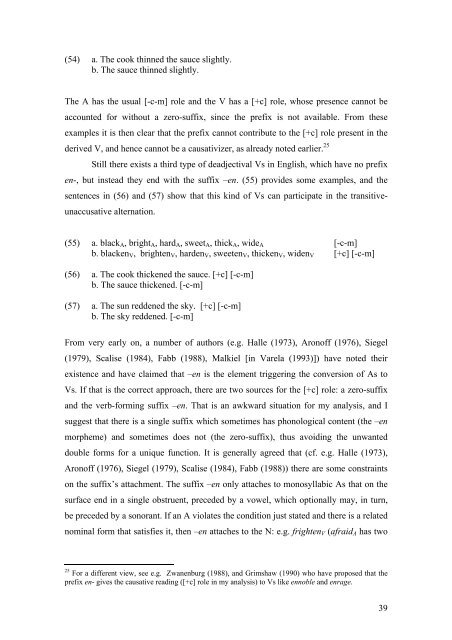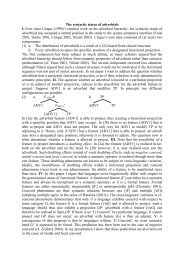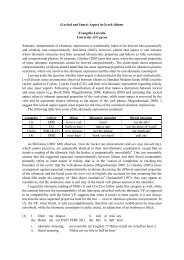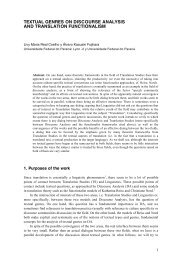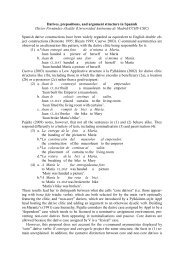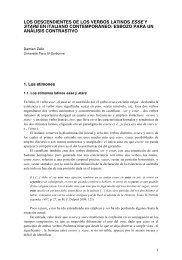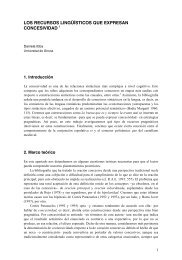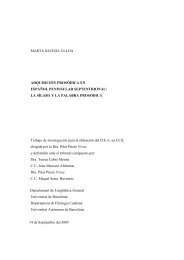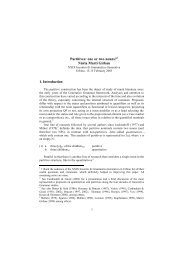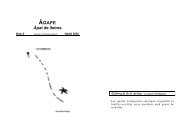Prefixation in English and Catalan - Departament de Filologia ...
Prefixation in English and Catalan - Departament de Filologia ...
Prefixation in English and Catalan - Departament de Filologia ...
You also want an ePaper? Increase the reach of your titles
YUMPU automatically turns print PDFs into web optimized ePapers that Google loves.
(54) a. The cook th<strong>in</strong>ned the sauce slightly.<br />
b. The sauce th<strong>in</strong>ned slightly.<br />
The A has the usual [-c-m] role <strong>and</strong> the V has a [+c] role, whose presence cannot be<br />
accounted for without a zero-suffix, s<strong>in</strong>ce the prefix is not available. From these<br />
examples it is then clear that the prefix cannot contribute to the [+c] role present <strong>in</strong> the<br />
<strong>de</strong>rived V, <strong>and</strong> hence cannot be a causativizer, as already noted earlier. 25<br />
Still there exists a third type of <strong>de</strong>adjectival Vs <strong>in</strong> <strong>English</strong>, which have no prefix<br />
en-, but <strong>in</strong>stead they end with the suffix –en. (55) provi<strong>de</strong>s some examples, <strong>and</strong> the<br />
sentences <strong>in</strong> (56) <strong>and</strong> (57) show that this k<strong>in</strong>d of Vs can participate <strong>in</strong> the transitiveunaccusative<br />
alternation.<br />
(55) a. blackA, brightA, hardA, sweetA, thickA, wi<strong>de</strong>A [-c-m]<br />
b. blackenV, brightenV, har<strong>de</strong>nV, sweetenV, thickenV, wi<strong>de</strong>nV [+c] [-c-m]<br />
(56) a. The cook thickened the sauce. [+c] [-c-m]<br />
b. The sauce thickened. [-c-m]<br />
(57) a. The sun red<strong>de</strong>ned the sky. [+c] [-c-m]<br />
b. The sky red<strong>de</strong>ned. [-c-m]<br />
From very early on, a number of authors (e.g. Halle (1973), Aronoff (1976), Siegel<br />
(1979), Scalise (1984), Fabb (1988), Malkiel [<strong>in</strong> Varela (1993)]) have noted their<br />
existence <strong>and</strong> have claimed that –en is the element trigger<strong>in</strong>g the conversion of As to<br />
Vs. If that is the correct approach, there are two sources for the [+c] role: a zero-suffix<br />
<strong>and</strong> the verb-form<strong>in</strong>g suffix –en. That is an awkward situation for my analysis, <strong>and</strong> I<br />
suggest that there is a s<strong>in</strong>gle suffix which sometimes has phonological content (the –en<br />
morpheme) <strong>and</strong> sometimes does not (the zero-suffix), thus avoid<strong>in</strong>g the unwanted<br />
double forms for a unique function. It is generally agreed that (cf. e.g. Halle (1973),<br />
Aronoff (1976), Siegel (1979), Scalise (1984), Fabb (1988)) there are some constra<strong>in</strong>ts<br />
on the suffix’s attachment. The suffix –en only attaches to monosyllabic As that on the<br />
surface end <strong>in</strong> a s<strong>in</strong>gle obstruent, prece<strong>de</strong>d by a vowel, which optionally may, <strong>in</strong> turn,<br />
be prece<strong>de</strong>d by a sonorant. If an A violates the condition just stated <strong>and</strong> there is a related<br />
nom<strong>in</strong>al form that satisfies it, then –en attaches to the N: e.g. frightenV (afraidA has two<br />
25 For a different view, see e.g. Zwanenburg (1988), <strong>and</strong> Grimshaw (1990) who have proposed that the<br />
prefix en- gives the causative read<strong>in</strong>g ([+c] role <strong>in</strong> my analysis) to Vs like ennoble <strong>and</strong> enrage.<br />
39


